Fleet Optimization, Last Mile Delivery Optimization, Retail & CPG, Route Optimization
How Electronic Proof of Delivery Software Improves Last Mile Customer Experience
Jan 27, 2020
7 mins read
Latest Update: Dec 1, 2020

Most digital and contactless services have seen increased adoption since April. With more than half of new and increased users reporting an intent to continue post-COVID-19. by McKinsey Survey: US consumer sentiment during the coronavirus crisis, Nov 2020
It would have seemed like a joke if someone had spoken seriously about contactless deliveries even a year ago. Today, it has become so prevalent due to the pandemic.
The truth is that contactless delivery is here to stay. The consumer is now looking out for brands that promise safety. It is now a part of the overall buying experience and could determine whether the consumer will choose to do business with the same brand again.
Logistics enterprises are now increasingly looking at Modern Electronic Proof of Delivery Applications to maintain safety and also improve customer experience.
What is Electronic Proof of Delivery (E-POD)?
Electronic Proof of Delivery in short ePOD is a digital acknowledgment of a traditional paper delivery receipt or note. With the help of ePOD, last-mile agents can capture data such as delivery confirmation on their mobile devices. It is usually done by taking an electronic signature of the customer after a successful delivery or by capturing a picture of the delivered order.
This paperless proof of delivery method increases safety and reduces the time taken by delivery agents to execute on-ground formalities. It also increases real-time visibility in your supply chain.
Why is Proof of Delivery Important?
There is strong intent to continue contactless activities across the United States. As an example, 79 percent of consumers intend to continue or increase their usage of self-checkout in retail after COVID-19. Millennials and Gen Z are the widest adopters of contactless activities. by McKinsey Research, The great consumer shift: Ten charts that show how US shopping behavior is changing.
Despite digitization and several advancements in logistics technology, many businesses, including large scale players still rely on paper-based proof of delivery methods throughout their supply chains. Such redundant manual processes are not just time-consuming, but also prone to inefficiencies created by workflow errors and human negligence. Add on top of it, the safety concerns in these times.
Electronic proof of delivery is a great tool for any enterprise with a mobile on-ground staff or providing delivery or at-home delivery services.
6 reasons why to invest in electronic proof of delivery app (E-POD) Software
A sophisticated and intuitive E-POD solution benefits not only your customer but also your on-ground staff and the decision-makers in your supply chain.
Here are the top 6 reasons you must consider while implementing an electronic proof of delivery solution in your supply chain during the COVID-19 pandemic and beyond. This will help in improving customer delight and enhancing business efficiency.
1. Boosts workforce productivity
Electronic Proof of Delivery improves the on-site delivery experience of on-ground personnel. With E-POD on their mobile devices, delivery representatives need not carry a bunch of delivery receipts along with the parcel. All they have to do is capture delivery confirmation on the E-POD application and share the status with their supervisor instantly.
It helps in setting up a standard last-mile delivery guideline for the on-ground staff to follow, thereby speeding up the delivery process, reducing unnecessary paperwork and enhancing workforce productivity on and off the field.
2. Enhances customer satisfaction
84% of customers will not return after just one poor delivery experience. The Perfect Order: Overcoming Roadblocks in Last Mile Experience, Convey, 2019
Real-time interaction throughout the delivery process is important to keep your customers informed about the whereabouts of their order. After delivering the parcel, the agent can send out an E-POD to the office staff and the customer in no time.
Since it is both secure and automated, it leaves no room for miscommunication about the delivery or false delivery confirmation by riders.
Replacing manual paperwork with E-POD also builds a professional and consistent buying experience, thereby leaving the customer with a better lasting impression and confidence in the brand.
3. Improves visibility in the supply chain
51% of consumers want real-time visibility into the status of their orders. – Retail TouchPoint Survey Report, Are you winning the last-mile of retail?, Mar 2018.
E-POD acts as an important tool to enhance end-to-end visibility in logistics. It not only simplifies the collection of data recorded by on-field workers but also sends real-time status updates to the office staff and alerts in case of any disputes or issues in the delivery process.
This helps in taking timely measures like negotiating with the customer or rearranging the delivery. Data sent in real-time is useful in monitoring delivery staff effectively, generating daily productivity reports, analyzing trends and identifying areas in the delivery process that need improvement.
4. Reduces paperwork and human errors
With E-POD, a lot of time spent on manual data entry is saved and the administrative burden of documenting for lost or damaged paper delivery notes is eliminated. These mobile applications are user-friendly, making daily tasks easier and removing the frustrations of delivery paperwork.

This means drivers are less likely to make errors in the delivery process, which results in greater accuracy in last mile logistics operations. Paperless proof of delivery is also a sustainable initiative towards green logistics and reducing the carbon footprint.
5. Enables contactless deliveries
“The ongoing coronavirus pandemic has strongly impacted the shopping behavior of consumers in the United States. A May 2020 survey revealed that 37 percent of respondents had used contactless delivery more than usual.” by U.S. shopping method usage change during coronavirus pandemic 2020, Statista
Whether it is food delivery, pharmaceutical delivery, groceries or meal-kit delivery, COVID-19 has spurred the growth of contactless deliveries.
Electronic Proof of Delivery App (Locus LOTR) enables the collection of contactless signatures and photo proofs of parcels / couriers being delivered without any physical presence of consumers. It helps drivers and field agents to easily verify customer details and deliver products on time..

6. Combats Failed Delivery Costs
Failed delivery attempts equate to an average 4.64 additional days of an item sitting at the destination terminal, and a minimum of $69 on average in added cost for the retailer. – Convey, Tactics that Make or Break the Home Delivery Appointment
Failed delivery costs have become one of the biggest concerns for the logistics industry. It affects on-time deliveries and impacts last-mile customer experience.
Locus Fleet Electronic Proof of Delivery Mobile App helps delivery agents to validate customers and inform fleet managers on the delivery status. It provides real-time notifications and alerts on failed deliveries. The data on failed deliveries helps fleet managers identify the reasons for it and rectify it.
In Conclusion
For the upcoming holiday season, more than 80 percent of Americans are making changes to how they celebrate, with more people cutting back on traveling and choosing to spend the holidays with immediate family members, hold gatherings in smaller groups, and celebrate virtually. – McKinsey Survey: US consumer sentiment during the coronavirus crisis, Nov 2020
Contactless deliveries will see a peak during this holiday season as most of the US consumers will prefer travelling less.
Logistics companies today have to maintain both efficiency and safety while delivering orders.
The last-mile is the only opportunity for most businesses to directly interact with end customers. This final step in logistics is critical to gain the trust and loyalty of the customer. Don’t let manual processes limit your chance to make a great impression on your customer.

References:
- https://www.mckinsey.com/business-functions/marketing-and-sales/our-insights/survey-us-consumer-sentiment-during-the-coronavirus-crisis
- https://www.mckinsey.com/business-functions/marketing-and-sales/our-insights/the-great-consumer-shift-ten-charts-that-show-how-us-shopping-behavior-is-changing
- https://www.getconvey.com/resource/retail-delivery-statistics-2/
- http://f9e7d91e313f8622e557-24a29c251add4cb0f3d45e39c18c202f.r83.cf1.rackcdn.com/RTP_RT153_SURV_LastMile_March_2018_FINAL.pdf?mkt_tok=eyJpIjoiTVdabVlUZzFZV1JoTmpnMCIsInQiOiJMWEJaUWZJWHBLNTZ6RkN6YUtrQ3lSM0VcL1Bac2ZjcG40VDRjSUJPcW13S3dBRmxDbWRVNFNKeVROVVlWNGtkRkpCOXlKV1ZSbnJLeE5mTTZvUmhOb3VlXC9JcG40eWlSbTg1a0hnWVJTMVI4V0g5NG5jZE14N0E1blJhTlwvMXRQNSJ9
- https://www.statista.com/statistics/583417/shopping-method-change-covid-19-usa/
Related Tags:

News
Reliance Now Set to Disrupt Indian E-commerce
Reliance launches its much-awaited e-commerce venture, JioMart, India’s newest online supermarket. Will it do to e-commerce what it did to telecom?
Read more
News
The Food Delivery Market Battle in India Set to Intensify With Zomato’s Acquisition of Ubereats
The foodtech industry is expected to heat up with Zomato's UberEats acquisition. What might be the opportunities for logistics and hyperlocal deliveries?
Read moreMOST POPULAR
EDITOR’S PICKS
SUBSCRIBE TO OUR NEWSLETTER
Stay up to date with the latest marketing, sales, and service tips and news


How Electronic Proof of Delivery Software Improves Last Mile Customer Experience